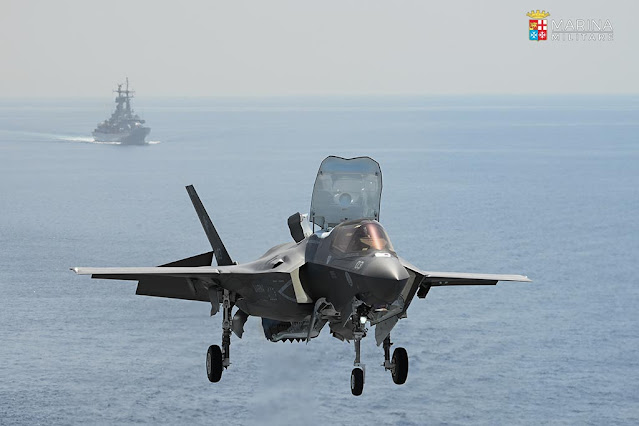Here is how to become Italian Navy pilot
 |
| Italian Navy F-35B pilot. |
The process to become an Italian Navy pilot begins with the selection of the best officers who attend the Naval Academy or through an annual external competition.
The long selection takes into account the knowledge of the English language, the passing of physical tests, the psychophysical fitness to fly, achieved with careful medical examinations at the Aerospace Medicine Institutes of the Italian Air Force.
Candidates begin an important pre-flight course at the Naval Academy during which they learn the first notions of aeronautics, and improve their physical prowess and knowledge of the English language.
Student pilots are subsequently sent to US Navy flight schools in the United States. They attend the first phase of training at NAS Pensacola, Florida, where they face tough athletic trials, including the nautical mile swam with flight equipment, land and sea survival tests and the study in English of all aeronautical subjects preparatory to flight (aerodynamics, meteorology, systems avionics).
After passing all the tests, the aspiring pilots are sent to NAS Whiting Field, Florida, to begin their real flying experience. They fly the T-6A Texan II aircraft for about 6 months together with American instructor officers.
Once this phase is completed, the selected students move to NAS Meridian, Mississippi, where they continue their training by flying the T-45 Goshawk jet. The process culminates with take-off and landing activities on aircraft carriers.
After "earning" US Navy pilot wings, officers are sent to MCAS Cherry Point, North Carolina, to fly the AV-8 or MCAS Beaufort, South Carolina, to fly the F-35B.
The long selection takes into account the knowledge of the English language, the passing of physical tests, the psychophysical fitness to fly, achieved with careful medical examinations at the Aerospace Medicine Institutes of the Italian Air Force.
Candidates begin an important pre-flight course at the Naval Academy during which they learn the first notions of aeronautics, and improve their physical prowess and knowledge of the English language.
Student pilots are subsequently sent to US Navy flight schools in the United States. They attend the first phase of training at NAS Pensacola, Florida, where they face tough athletic trials, including the nautical mile swam with flight equipment, land and sea survival tests and the study in English of all aeronautical subjects preparatory to flight (aerodynamics, meteorology, systems avionics).
After passing all the tests, the aspiring pilots are sent to NAS Whiting Field, Florida, to begin their real flying experience. They fly the T-6A Texan II aircraft for about 6 months together with American instructor officers.
Once this phase is completed, the selected students move to NAS Meridian, Mississippi, where they continue their training by flying the T-45 Goshawk jet. The process culminates with take-off and landing activities on aircraft carriers.
After "earning" US Navy pilot wings, officers are sent to MCAS Cherry Point, North Carolina, to fly the AV-8 or MCAS Beaufort, South Carolina, to fly the F-35B.
Students not selected for the jets move on to the next phase, called "Intermediate", lasting four weeks. They then move to NAS Corpus Christi, Texas, to undergo training for about six months and "earn" the US Wings of Gold. In this phase they fly the Beechcraft T-44 advanced twin-engine training aircraft.
Subsequently, the officers are further divided between those destined for the P-72A patrol aircraft, which return to Italy, and those destined for the rotary wing (helicopter) who return to Whiting Field where they spend another six months of training to complete the transition to TH-57 helicopter.
Advanced training takes place on land and sea, where pilots acquire landing techniques and basic operational tactics for anti-submarine and search and rescue missions.
Upon returning to Italy, they follow different training procedures according to the needs of the Italian Navy, in order to obtain the qualification to fly the EH-101 or SH-90 helicopter. Their possible destinations are three: the helicopter bases of Luni-Sarzana, Grottaglie or Catania.
Subsequently, the officers are further divided between those destined for the P-72A patrol aircraft, which return to Italy, and those destined for the rotary wing (helicopter) who return to Whiting Field where they spend another six months of training to complete the transition to TH-57 helicopter.
Advanced training takes place on land and sea, where pilots acquire landing techniques and basic operational tactics for anti-submarine and search and rescue missions.
Upon returning to Italy, they follow different training procedures according to the needs of the Italian Navy, in order to obtain the qualification to fly the EH-101 or SH-90 helicopter. Their possible destinations are three: the helicopter bases of Luni-Sarzana, Grottaglie or Catania.
As soon as the pilots have obtained the first qualifications for operational employment, they begin the exciting adventure aboard the ships of the Italian Navy where they obtain the qualifications to participate in real operations.
👉 You may also like: First female Italian Navy strike fighter pilot earns Wings of Gold
Written by Matteo Sanzani
Source, Images: Italian Navy
Source, Images: Italian Navy







No comments
All comments related to the contents of our articles are welcome. It is not allowed to post promotional messages, links to external sites, or references to activities not related to this blog.